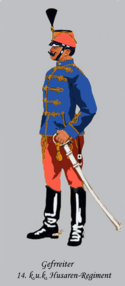14 Pułk Huzarów (austro-węgierski)
Pułk Huzarów Kolossváry Nr 14 (HR. 14) – pułk kawalerii cesarskiej i królewskiej Armii.
Pełna nazwa niemiecka: Husarenregiment Kolossváry Nr 14[1].
Data utworzenia: 1859 rok[2].
Szef pułku: generał kawalerii Desiderius Kolossváry de Kolosvár (od 1913)[2].
W 1914 roku pułk stacjonował w Nyíregyháza na terytorium 6 Korpusu i wchodził w skład 6 Brygady Kawalerii w Miszkolcu[3].
Organizacja pokojowa pułku
- Komenda
- pluton pionierów
- patrol telegraficzny
- kadra zapasowa
- 1. dywizjon
- 2. dywizjon
W skład każdego dywizjonu wchodziły trzy szwadrony liczące 117 dragonów. Stan etatowy pułku liczył 37 oficerów oraz 874 podoficerów i żołnierzy.
Komendanci pułku
- płk Franz Matskási von Tinkova (1913 – 1914[2])
Przypisy
- ↑ Za: Österreich-Ungarns letzter Krieg według pułkownika D. Maximiliana Enhla.
- ↑ a b c Rocznik oficerski c. i k. Armii i Marynarki Wojennej 1914 ↓, s. 720.
- ↑ Rocznik oficerski c. i k. Armii i Marynarki Wojennej 1914 ↓, s. 93, 720.
Bibliografia
Media użyte na tej stronie
Private 1st class of the 2nd Austria-Hungarian Hussards-Regiment. Uniform in use until about 1916
Korpskommandant G. d. K. Kolosváry von Kolosvár
Autor: Ta ^specifik^ z W3C grafika wektorowa została stworzona za pomocą Inkscape ., Licencja: CC BY-SA 3.0
Naval Ensign of Austria-Hungary, used from 1894 to 1915.
Autor:
- Imperial_Standard_of_Austria_(1828-Late_19th_Century).svg: Buho07
- Wappen_Kaisertum_Österreich_1867_(Mittel).png:
| Hugo Gerard Ströhl
(1851–1919) |
|||
|---|---|---|---|
 |
|||
| Inne nazwiska i pseudonimy |
Hugo Gerhard Ströhl | ||
| Opis | austriacki grafik, heraldyk i artysta | ||
| Data urodzenia/śmierci |
24 września 1851 |
7 grudnia 1919 | |
| Miejsce urodzenia/śmierci | Wels | Mödling | |
| Miejsce działalności | |||
| Kontrola autorytatywna | |||
Upload David Liuzzo
- Imperial Coat of Arms of the Empire of Austria.svg: Adelbrecht
- derivative work: RhoDaZZ (talk)
Imperial Standard of the Austrian Empire with Medium Coat of arms. Used until 1915 also for the Austro-Hungarian Empire. >>> See <<<









